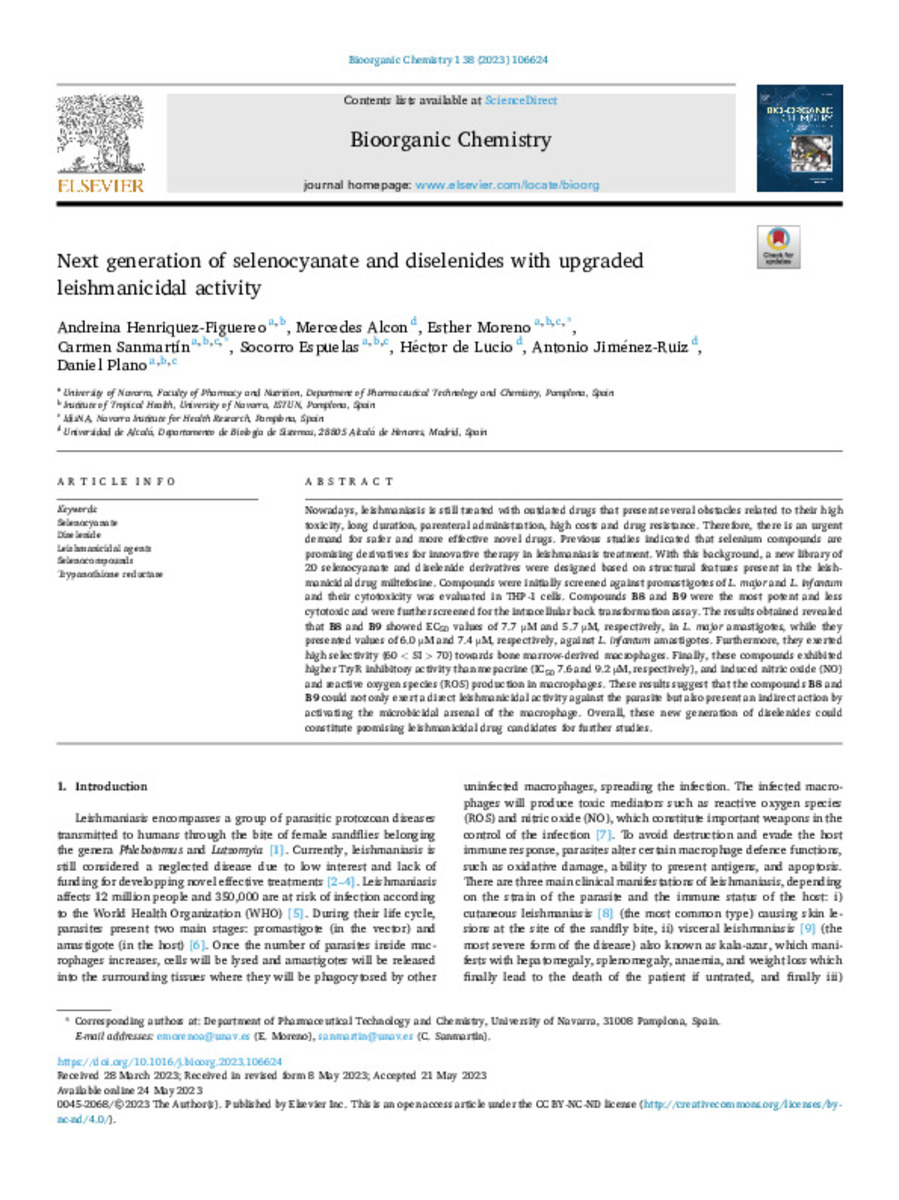Full metadata record
| DC Field | Value | Language |
|---|---|---|
| dc.creator | Henriquez-Figuereo, A. (Andreina) | - |
| dc.creator | Alcon, M. (Mercedes) | - |
| dc.creator | Moreno, E. (Esther) | - |
| dc.creator | Sanmartin-Grijalba, C. (Carmen) | - |
| dc.creator | Espuelas, S. (Socorro) | - |
| dc.creator | de-Lucio, H. (Héctor) | - |
| dc.creator | Jiménez-Ruiz, A. (Antonio) | - |
| dc.creator | Plano-Amatriain, D. (Daniel) | - |
| dc.date.accessioned | 2023-10-20T07:42:06Z | - |
| dc.date.available | 2023-10-20T07:42:06Z | - |
| dc.date.issued | 2023 | - |
| dc.identifier.citation | Henriquez-Figuereo, A. (Andreina); Alcon, M. (Mercedes); Moreno, E. (Esther); et al. "Next generation of selenocyanate and diselenides with upgraded leishmanicidal activity". Bioorganic Chemistry. 138, 2023, 106624 | es |
| dc.identifier.issn | 1090-2120 | - |
| dc.identifier.uri | https://hdl.handle.net/10171/67681 | - |
| dc.description.abstract | Nowadays, leishmaniasis is still treated with outdated drugs that present several obstacles related to their high toxicity, long duration, parenteral administration, high costs and drug resistance. Therefore, there is an urgent demand for safer and more effective novel drugs. Previous studies indicated that selenium compounds are promising derivatives for innovative therapy in leishmaniasis treatment. With this background, a new library of 20 selenocyanate and diselenide derivatives were designed based on structural features present in the leishmanicidal drug miltefosine. Compounds were initially screened against promastigotes of L. major and L. infantum and their cytotoxicity was evaluated in THP-1 cells. Compounds B8 and B9 were the most potent and less cytotoxic and were further screened for the intracellular back transformation assay. The results obtained revealed that B8 and B9 showed EC50 values of 7.7 µM and 5.7 µM, respectively, in L. major amastigotes, while they presented values of 6.0 µM and 7.4 µM, respectively, against L. infantum amastigotes. Furthermore, they exerted high selectivity (60 < SI > 70) towards bone marrow-derived macrophages. Finally, these compounds exhibited higher TryR inhibitory activity than mepacrine (IC50 7.6 and 9.2 µM, respectively), and induced nitric oxide (NO) and reactive oxygen species (ROS) production in macrophages. These results suggest that the compounds B8 and B9 could not only exert a direct leishmanicidal activity against the parasite but also present an indirect action by activating the microbicidal arsenal of the macrophage. Overall, these new generation of diselenides could constitute promising leishmanicidal drug candidates for further studies. | es_ES |
| dc.description.sponsorship | This research was financially supported by the Plan de Investigación de la Universidad de Navarra, PIUNA (2018-19) and by the Institute of Tropical Health of University of Navarra (ISTUN), Caixa Foundation, Roviralta and Ubesol, Spain. AH-F gratefully acknowledges the support provided by the Institute of Tropical Health of University of Navarra (ISTUN) for her Ph.D. fellowship. | es_ES |
| dc.language.iso | eng | es_ES |
| dc.publisher | Elsevier | es_ES |
| dc.rights | info:eu-repo/semantics/openAccess | es_ES |
| dc.subject | Diselenide | es_ES |
| dc.subject | Leishmanicidal agents | es_ES |
| dc.subject | Selenocompounds | es_ES |
| dc.subject | Selenocyanate | es_ES |
| dc.subject | Trypanothione reductase | es_ES |
| dc.title | Next generation of selenocyanate and diselenides with upgraded leishmanicidal activity | es_ES |
| dc.type | info:eu-repo/semantics/article | es_ES |
| dc.description.note | This is an open access article under the CC BY-NC-ND license | es_ES |
| dc.identifier.doi | 10.1016/j.bioorg.2023.106624 | - |
| dadun.citation.publicationName | Bioorganic Chemistry | es_ES |
| dadun.citation.startingPage | 106624 | es_ES |
| dadun.citation.volume | 138 | es_ES |
| dc.identifier.pmid | 37295238 | - |
Files in This Item:
Statistics and impact
Items in Dadun are protected by copyright, with all rights reserved, unless otherwise indicated.






